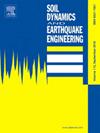Fuzzy-based method for seismic soil structure interaction and performance evaluation of subway stations
IF 4.2
2区 工程技术
Q1 ENGINEERING, GEOLOGICAL
引用次数: 0
Abstract
The selection of representative ground motion intensity measure (IM) and structural engineering demand parameter (EDP) is the crucial prerequisite for evaluating structural seismic performance within the performance-based earthquake engineering (PBEE) framework. This study focuses on this crucial step in developing the probabilistic seismic demand model for two-story and three-span subway stations exposed to transverse seismic loadings in three different ground conditions. The equivalent linearization approach is used to simulate the shear modulus degradation and the increase in damping characteristics of the soil under seismic excitation. Nonlinear fiber beam-column elements are adopted to characterize the nonlinear hysteretic degradation of the subway station structure during seismic events. A total of 21 far-field ground motions are selected from the PEER strong ground motion database. Nonlinear incremental dynamic analyses (IDAs) are conducted to evaluate the seismic response of the subway station. A suite of 23 ground motion IMs is evaluated using the criteria of correlation, efficiency, practicality, and proficiency. Then, a multi-level fuzzy evaluation method is employed to integrate these evaluation criteria and determine the optimal ground motion IMs in different ground conditions. The peak ground acceleration and sustained maximum acceleration are demonstrated to be the optimal ground motion IM candidates for shallowly buried rectangular underground structures in site classes I, II, and III, while the root-mean-square displacement and compound displacement are found to be not suitable for this purpose.
求助全文
约1分钟内获得全文
求助全文
来源期刊

Soil Dynamics and Earthquake Engineering
工程技术-地球科学综合
CiteScore
7.50
自引率
15.00%
发文量
446
审稿时长
8 months
期刊介绍:
The journal aims to encourage and enhance the role of mechanics and other disciplines as they relate to earthquake engineering by providing opportunities for the publication of the work of applied mathematicians, engineers and other applied scientists involved in solving problems closely related to the field of earthquake engineering and geotechnical earthquake engineering.
Emphasis is placed on new concepts and techniques, but case histories will also be published if they enhance the presentation and understanding of new technical concepts.
 求助内容:
求助内容: 应助结果提醒方式:
应助结果提醒方式:


